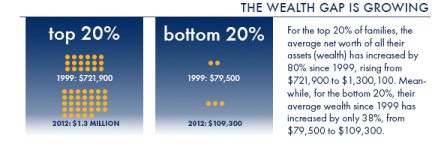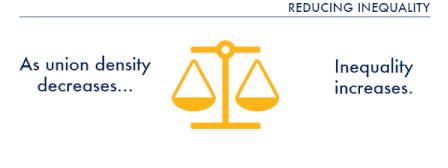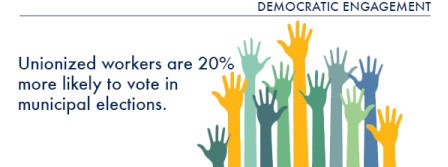Many right-wing attacks on unions have centered around the notion that unions are no longer relevant. Yet, as this research note strives to make clear, in light of the growing material inequality gripping Canada, it is clear that unions remain relevant – perhaps more than ever – and there is no shortage of evidence to support this.

Income inequality is on the rise. As the International Labour Organization (ILO) makes clear in its annual global wage report, wages remained stagnant from 2012-2013 in developed economies, and in some countries, continue to remain below pre-recession levels.[1] These stagnant wages actually represent a loss for workers, as over the same period of time labour productivity growth has outstripped real wage growth. As a result, in some of the largest developed economies, labour’s share of national income has fallen.[2] This inequality is being experienced in Canada as well. In a recent report, data analyzed by Statistics Canada reveals that from 1999-2012 the average wealth of families in the top quintile increased by 80% from $721,900 to $1.3 million.[3] In comparison, the average wealth of those in the bottom quintile increased to only $109,300.[4] As a result, Canada ranks an abysmal 12th out of 17 countries in terms of income equality, and receives a “C” from the Conference Board of Canada in terms of promoting an equitable standard of living.[5]
One reason for this inequality can be traced to the relentless attacks on unions and the resulting decline in union density. A Massachusetts Institute of Technology (MIT) study notes that decreasing union density accounts for over one quarter of the rise in inequality over the past 30 years.[6] This increase in inequality can be attributed to the fact that unlike non-union jobs, union jobs carry two types of premiums, a wage premium,[7] and a voting premium,[8] both of which combat inequality.

The wage premium is arguably self-evident, as unions help members secure better pay. Unions narrow income gaps both within and outside of the workplace. As economist Paul Krugman explains, the wage premium manifests itself within the workplace in two ways. First, unions are known to compress income gaps within the bargaining unit itself, by negotiating bigger wage increases for the unit’s worst-paid members.[9] Second, the income gap between blue collar and white collar employees is reduced, as unions promote, “a rise in the wages of blue collar workers compared to managers and professionals.”[10] The wage increases unions achieve for their membership affects non-union members as well. Non-unionized employers are often forced to address the appeal of union drives by raising the standing of their employees.[11]
Krugman’s analysis is further supported by the work of researchers at the International Monetary Fund (IMF). In a recent study, researchers from the IMF demonstrate that lower union density increases the income shares of those on the top by reducing the bargaining power of workers.[12] De-unionization can weaken earnings for middle and low-income workers, which naturally increases the income share of corporate managers’ pay and shareholders’ return.[13] Thus, it is clear that unlike non-union jobs, unionized jobs combat material inequality by reducing inequities in pay.
The second reason that decreasing union density may be associated with the rising inequality gripping Canada is because union jobs have a voting premium. In democratic societies, such as Canada, the policy decisions, which have an impact on our lives on a daily basis, generally lie in the hands of elected officials. Yet, according to Elections Canada data, voter turnout has been declining since 1963.[14] Research reveals that the most pronounced decrease is amongst those generally on the margins of society: younger workers, those with fewer years of education, and citizens with immigrant backgrounds.[15] Arguably, this group of people risks falling the furthest behind as wealth becomes more concentrated.

How does this relate to unions? This decline in voter turnout has been accompanied by a decline in union density. Unions have a long and proud tradition of mobilizing and educating middle-class Canadians on the importance of public service. In one study, researchers explain that since union members are exposed to the formalities of collective bargaining and running for union elections, they are thus more likely to increase their attachment to, and willingness to participate in Canada’s democratic processes outside of the workplace.[16] As a result, union members are 10-12% more likely to vote than non-members in all forms of measured voting behavior, with a 20% increased likelihood of voting in municipal elections when compared to non-union members.[17] These voting patterns are most pronounced amongst under-represented groups when it comes to voting, namely those with fewer years of education, immigrants and younger workers.[18] It is these groups that not only have lower rates of voter participation, but have also become increasingly marginalized as wealth is concentrated. Thus, it is not surprising that when union jobs that help those on the margins of society exercise their democratic right for their own betterment decrease, the gap between the haves and have-nots increases.
With inequality at record levels and with an abundance of research detailing how union jobs help combat this inequality, it may come as little surprise that public perception of unions, and their supporters, in countries such as the United States and Canada is on the rise. According to the results of a recent Gallup survey, nearly six in 10 Americans have a favorable view of labour unions – an increase of 10% from 2009.[19] Likewise in Canada, the labour-backed New Democratic Party appears to be building on its historic victory in Alberta, with their best chance to date of winning the current federal election. Clearly unions remain relevant – now more so than ever.
___________________
[1] International Labour Organization, Global Wage Report 2014/15: Wages and income inequality (Geneva: Document and Publications Production, Printing and Distribution Branch, 2015), v.
[2] Ibid, xvi.
[3] Statistics Canada, Changes in wealth across the income distribution, 1999 to 2012 (Ottawa), 1.
[4] Ibid.
[5] Conference Board of Canada, “Income Inequality”, accessed on August 17, 2015, http://www.conferenceboard.ca/hcp/details/society/income-inequality.aspx.
[6] Brigham R. Frandsen, “Why Unions Still Matter: The Effects of Unionization on the Distribution of Employee Earnings”, Massachusetts Institute of Technology (2012): 30.
[7] The term wage premium refers to the degree in which union wages exceed non-union member wages. This term is widely used in labour economics and appears in the works of numerous economists such as Paul Krugman.
[8] The term voting premium is used in the work of Alex Bryson, Rafael Gomez, Tobias Kretschmer and Paul Willman in similar fashion to the term wage premium – in this case it refers to how much more likely unionized workers are to vote than non-union workers.
[9] Paul Krugman, “The Great Compression” in The Conscience of a Liberal, (New York: W. W. Norton & Company Inc.), 51.
[10] Ibid.
[11] Ibid.
[12] International Monetary Fund, “Power from the people”, Finance & Development (2015): 31.
[13] Ibid, 31.
[14] Elections Canada, “Estimation of Voter Turnout by Age Group and Gender at the 2011 Federal General Election”, accessed on August 17, 2015, http://www.elections.ca/content.aspx?section=res&dir=rec/part/estim/41ge&document=report41&lang=e.
[15] Alex Bryson, Rafael Gomez, Tobias Kretschmer and Paul Willman, “Workplace Voice and Civic Engagement: What Theory and Data Tell Us About Unions and Their Relations to the Democratic Process”, Osgoode Hall Law Journal (2013): 981.
[16] Ibid, 965.
[17] Ibid, 984 and 987.
[18] Ibid, 987.
[19] Gallup, “Americans’ Support for Labour Unions Continues to Recover”, accessed on August 17, 2015, http://www.gallup.com/poll/184622/americans-support-labor-unions-continues-recover.aspx.
DownloadRequest this file in a different format
